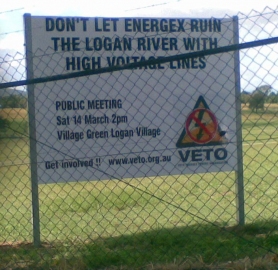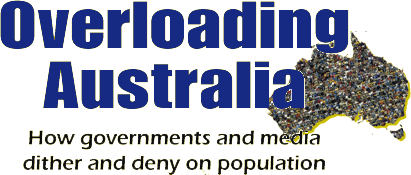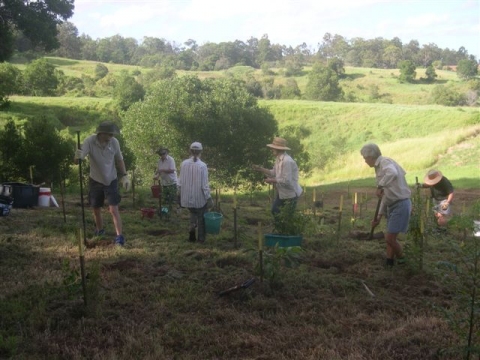
Logan and Albert Conservation Association

 Do you want to see HIGH VOLTAGE POWER LINES criss cross the Logan River?
Do you want to see HIGH VOLTAGE POWER LINES criss cross the Logan River?
Do you want your environment affected by HIGH VOLTAGE POWER LINES?
Do you know whether your property will be affected by HIGH VOLTAGE POWER LINES?
Do you want to see your property devalued by HIGH VOLTAGE POWER LINES?
If you answered NO to any of the above questions you should attend this meeting.
For further information contact Maree Slingsby VETO's Spokesperson on 0408 765 847
SHADES OF KOALA WARS - VETO RE- GROUPS
Australians in dark on emissions effort are the headlines in today's Australian newspaper 23 February 2009.
Polling to be published by the Australia Institute this week found almost 90 per cent of respondents believe households and individuals should be able to contribute to reducing national greenhouse emissions. Read the article here.
Contact your local members for state and federal government and tell them what you want.
Personally I believe my own actions to lessen the pollution my actions have caused should be measured accounted and encouraged.
 Koalas get more than 90 per cent of their water from eucalyptus leaves. Eucalyptus leaves - which koalas depend on for survival - are being destroyed by abnormally high levels of greenhouse gases. Scientists warned early in 2008 that increased levels of carbon dioxide in the atmosphere were reducing nutrient levels in the leaves, and also boosting their toxic tannin content.
Koalas get more than 90 per cent of their water from eucalyptus leaves. Eucalyptus leaves - which koalas depend on for survival - are being destroyed by abnormally high levels of greenhouse gases. Scientists warned early in 2008 that increased levels of carbon dioxide in the atmosphere were reducing nutrient levels in the leaves, and also boosting their toxic tannin content.
Koala is an aboriginal word that means "doesn't drink". This is because koalas get more than 90 per cent of their water from eucalyptus leaves, which are toxic to most species. The only time they drink is when they fall ill or there is not enough moisture on leaves such as during droughts.
Click read more to view photos taken in Victoria earlier this year. They illustrate how desperately thirsty these wild animals are if they are prepared to approach humans to get water.
 To build long term sustainable and happy communities we must stabilize our populations within the carrying capacity of our region.
To build long term sustainable and happy communities we must stabilize our populations within the carrying capacity of our region.
Co-author Mark O'Connor Mark will be building on the arguments in his previous book, This Tired Brown Land, which outlines the reasons for the low human carrying capacity of Australia.
"After a decade of being told Australia's population would naturally cap itself at under 25 million, or might even fall, we now discover it is growing at the more than Third World rate of 1.7% a year, and is on course to reach 42 million by 2050, and over 100 million by 2100," said Mark.
 'New research makes roads safer for koalas' is the statement released on Monday, 16 February 2009 by Minister for Main Roads and Local Government
'New research makes roads safer for koalas' is the statement released on Monday, 16 February 2009 by Minister for Main Roads and Local Government
The Honourable Warren Pitt. The press release is quoted towards the end of this article.
While it is commendable that the minister and his Departments recognize the terrible impact that road construction has on the mortality of koalas and other animals, this 'solution' is not recognising the major impact on the long term survival of koalas in SEQ and elsewhere.
The greatest cause of decline for koalas is LOSS OF HABITAT for any reason. The future proposal for huge increases in population to SEQ, Logan Ipswich and Scenic Rim Region in particular, will result in habitat loss for koalas for both human dwellings and infrastructure deemed necessary those people.
Here is the first draft of the SEQ Regional Plan Survey. It only allows for 10 questions - more questions requires a subscription. $20.00 per month or $200 per year and i assume that is $US.
Click Here to take survey
LACA recently submitted this media release to local papers: Jimboomba Times, Logan West Leader, Beaudesert Times.
The recent rehabilitation and return of Babe the koala to Jimboomba after a dog attack is great news. Despite this happy ending, koalas in South-east Queensland are under serious threat and urgently need our help.
According to the EPA and Australian Koala Foundation, koala populations are in decline in many parts of South-east Queensland. The greatest threats to koalas after habitat loss are cars and dogs.
GHD consultants are currently collecting koala sightings for South-east Queensland as part of a state government Koala Habitat Mapping Project. Koala information can be forwarded to This email address is being protected from spambots. You need JavaScript enabled to view it. by 5 pm Friday 13th February.
A previous report by GHD consultants for Moreton Regional Council in 2008 showed a 46% decline in the last 6 years in Pine Rivers' urban koala population density. An EPA report in 2007 also showed koala numbers in the Koala Coast Area (including parts of Brisbane City Council, Redlands and Logan) had declined by 27 % from 6246 in 1997 to 4610 in 2005. Koala populations in Logan had declined by 26% and Brisbane by 21%. The largest declines occurred in areas associated with the Urban Footprint.
"The Koala Coast Area has traditionally been recognized in South-east Queensland as having a higher density of koalas and being a koala stronghold. But with koala numbers now confirmed to be in decline in these areas, this makes koalas in other parts of South-east Queensland such as Logan and Scenic Rim crucial to sustaining this iconic species for the future," said Anne Page, spokesperson for the Logan and Albert Conservation Association.
The EPA report also concluded that it was critical to maintain koala populations in urban and bushland areas to sustain viable and healthy populations.
"It is critical that koala habitat is identified and protected now for the best environmental outcomes. Koalas are the faunal emblem of Queensland and an iconic Australian animal famous worldwide - it is up to all of us to help protect this species for future generations."
Despite these predicted declines in koalas in South-east Queensland, massive development is still proposed for Logan Council and Scenic Rim Regional Council with population increases of 30 000 for Park Ridge MPA, 25 000 for Greenbank, 60 000 for Flagstone and 60 000 for Yarrabilba as part of the SEQRP. The koala populations of Logan Council and the Scenic Rim Regional Council are still unknown. To date no official koala surveys have been conducted to identify and map Koala Conservation Areas.
"Under the Koala Conservation Plan, the areas with the highest level of protection are Koala Conservation Areas, but these areas must be surveyed and mapped. Without koala mapping, no serious protection is given to koalas," said Anne Page. Previous community reported sightings collected by LACA confirm that koalas occur in Logan Village, Chambers Flat, Park Ridge, Park Ridge South, Munruben Woods, Munruben Forest, Greenbank, New Beith, Flagstone, North Maclean, Tamborine, Mundoolun, Jimboomba, Stockleigh, Yarrabilba, Buccan, Veresdale Scrub, Cedar Vale, Canungra, Palen Creek, Mt Barney, Rathdowney, Cedar Creek, Wolffdene, Rathdowney, Beaudesert, and Bromelton.
You can help protect the koala
• Do encourage local and state government to fast track koala mapping for local area
• Do drive slowly through wildlife signed areas or habitat areas
• Do secure dogs at night
• Do report koala sightings in your local area to EPA Wildnet.
The community may also comment on the Draft Koala State Planning Regulatory Provisions until 27 February.
Enquiries can be made on 1800 070 609. More detail can be obtained on www.laca.org.au
Contact Details: Anne Page (Secretary) ph 3297 0624 or Kathy Faldt (Vice President) ph 3200 0129
The tragic bushfires in Victoria will change forever the way we live in the bush. Both human and animal suffering and death are cruel and soul destroying. However the people of Australia and global communities are rallying to support the survivors.
'Sam' the koala may or may not have been a victim of the fires but she is definitely a victim of the intense drying heat in Victoria which has dessicated the leaves of the eucalypts such that thirst has overcome warriness of humans for many Victorian koalas who have allowed humans close enough to provide water.
It is commonly believed that koalas do not drink water. Whenever they do it is an indication of stress.
These websites are accepting donations to help the animal survivors - both native and domestic animals. You can donate securely online at www.wildlifevictoria.org.au and www.rspcavic.org.au.
 IFAW's Emergency Relief Team is already on the ground helping local wildlife caretakers with search and rescue operations, providing medical treatment to burned and abandoned animals that are emerging from the fire zone - koalas, possums, kangaroos, dogs, even horses and birds - as well as food and vet supplies. But recovery for many animals will be a long process, and we desperately need to raise funds to help over the long term with medical supplies, animal cages, blankets and towels.
IFAW's Emergency Relief Team is already on the ground helping local wildlife caretakers with search and rescue operations, providing medical treatment to burned and abandoned animals that are emerging from the fire zone - koalas, possums, kangaroos, dogs, even horses and birds - as well as food and vet supplies. But recovery for many animals will be a long process, and we desperately need to raise funds to help over the long term with medical supplies, animal cages, blankets and towels.
You can also donate through IFAW the International Fund for Animal Welfare to provide emergency relief to animals in crises, and save pets and wildlife around the world.
 There exists a blatant contradictory flaw in state legislation that permits areas deemed worthy of 999 year conservation agreements between state and landholder to be quashed by short-term mining ventures.
There exists a blatant contradictory flaw in state legislation that permits areas deemed worthy of 999 year conservation agreements between state and landholder to be quashed by short-term mining ventures.
In particular, we draw attention to 'Bimblebox Nature Refuge' in the Desert Uplands which was part-funded by the Commonwealth National Reserve System Programme, on account of its outstanding floristic values. It has since become a stable base for numerous scientific research projects relevant to the entire bioregion. 'Bimblebox' is now threatened by the development of a large open-cut coal mine.
For further information go to website. Several research programs and monitoring are occurring at the valuable biodiversity site. Coal exploration activities are likely to affect the results of these ongoing monitoring activities, by creating increased human presence in a relatively isolated area, increasing ‘edge effects' on woodland fauna, and resulting in significant amounts of clearing.
 Snapshot of our energetic working bee organised by our volunteer project manager Carla Parker. (Click read more for the gallery.)
Snapshot of our energetic working bee organised by our volunteer project manager Carla Parker. (Click read more for the gallery.)
We appreciate all of her efforts and dedication towards protecting and reinstating the endangered Veresdale Scrub dry vine rainforest in the Scenic Rim and also now in Logan City.
Bilarabyn Reserve is being revegetated with some Envirofund funding for materials and Saturday 7 February was a planting working bee. LACA has developed a management plan and is working with Scenic Rim Regional Council who have overall responsibility for managing the site for state government.